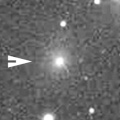
|
Now it is 10.6 mag (June 24, Marco Goiato). It will fade out rapidly after this. It will be unobservable in October. But it will be observable again in July. It is somewhat fainter than this ephemeris recently.
Date(TT) R.A. (2000) Decl. Delta r Elong. m1 Best Time(A, h)
July 1 0 8.04 -28 30.9 0.903 1.544 106 9.2 3:03 (325, 17)
July 8 23 31.92 -37 34.4 0.715 1.520 121 8.6 3:08 (343, 15)
|
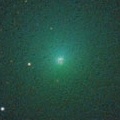
|
It brightened very rapidly. Now it is 10.0 mag (June 23, Katsumi Yoshimoto). It will fade out rapidly after this. In the Northern Hemisphere, it stays observable in good condition. In the Southern Hemisphere, it is not observable now, but it will appear in August.
Date(TT) R.A. (2000) Decl. Delta r Elong. m1 Best Time(A, h)
July 1 14 39.52 79 33.1 0.646 1.027 72 9.3 21:04 (176, 45)
July 8 16 14.76 80 42.2 0.603 1.033 74 9.2 21:16 (180, 44)
|

|
Now it is 10.2 mag (June 19, Hiroshi Abe). It stays 10 mag for a while. It will be getting higher gradually.
Date(TT) R.A. (2000) Decl. Delta r Elong. m1 Best Time(A, h)
July 1 3 9.54 14 59.3 2.837 2.311 49 9.9 3:03 (261, 14)
July 8 3 11.36 13 12.3 2.738 2.334 56 9.9 3:08 (267, 19)
|

|
It brightened up to 8 mag from 2022 summer to 2023 spring. Now it is 10.8 mag (June 10, Chris Wyatt). It stays 12 mag for a while. In the Northern Hemisphere, it is not observable now, but it will appear in August. In the Southern Hemisphere, it will be getting higher gradually.
Date(TT) R.A. (2000) Decl. Delta r Elong. m1 Best Time(A, h)
July 1 5 59.91 -11 34.5 3.720 2.957 35 11.2 3:03 (258,-36)
July 8 6 6.90 -10 48.9 3.777 3.019 36 11.3 3:08 (262,-30)
|
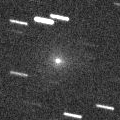
|
It is expected to brighten up to 11 mag in July. Now it is 13.1 mag (June 22, Thomas Lehmann). It will fade out rapidly after this. It stays extremely low. But it will become high in autumn in the Northern Hemisphere.
Date(TT) R.A. (2000) Decl. Delta r Elong. m1 Best Time(A, h)
July 1 3 52.67 22 30.6 1.515 0.947 37 11.8 3:03 (249, 10)
July 8 4 29.27 22 33.8 1.536 0.933 36 11.5 3:08 (249, 9)
|
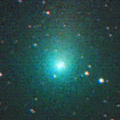
|
It brightened up to 9.5 mag from winter to early spring (Jan. 30, Katsumi Yoshimoto). Now it is 11.8 mag (June 18, Ken-ichi Kadota). It will fade out rapidly after this. In the Northern Hemisphere, it stays observable in good condition. In the Southern Hemisphere, it will be getting higher gradually.
Date(TT) R.A. (2000) Decl. Delta r Elong. m1 Best Time(A, h)
July 1 0 58.81 33 41.7 2.502 2.413 73 12.3 3:03 (256, 49)
July 8 0 56.33 32 43.8 2.436 2.472 80 12.4 3:08 (261, 55)
|
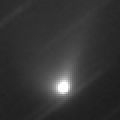
|
It brightened very rapidly as expected. Now it is 11.8 mag (June 17, Osamu Miyazaki). It will fade out rapidly after this. It stays observable in good condition.
Date(TT) R.A. (2000) Decl. Delta r Elong. m1 Best Time(A, h)
July 1 19 54.24 -1 36.8 1.070 2.023 151 12.4 1:21 ( 0, 53)
July 8 19 49.88 -0 37.7 1.064 2.034 155 12.5 0:49 ( 0, 54)
|

|
Now it is 13.2 mag (June 18, Hiroshi Abe). It stays 13 mag for a while. It will be unobservable soon in the Northern Hemisphere, or in August in the Southern Hemisphere. But it will be observable again in September in the Southern Hemisphere, or in October in the Northern Hemisphere.
Date(TT) R.A. (2000) Decl. Delta r Elong. m1 Best Time(A, h)
July 1 10 20.35 -7 30.0 4.079 3.720 62 12.4 21:04 ( 78, 4)
July 8 10 20.60 -8 14.1 4.196 3.735 56 12.5 21:02 ( 81, -2)
|

|
Now it is 12.8 mag (June 19, Chris Wyatt). Fading slowly. In the Northern Hemisphere, it is not observable now. In the Southern Hemisphere, it stays observable in good condition. It was expected to brighten up to 10 mag from spring to summer. However, it is fainter than originally expected.
Date(TT) R.A. (2000) Decl. Delta r Elong. m1 Best Time(A, h)
July 1 18 53.68 -87 59.4 2.546 3.117 115 12.5 0:46 ( 0,-33)
July 8 12 50.63 -87 45.1 2.597 3.129 112 12.6 21:02 ( 2,-34)
|
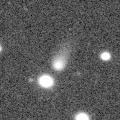
|
It is expected to brighten up to 7 mag in early 2024. Now it is 14.1 mag (June 19, Chris Wyatt). Brightening gradually. In the Northern Hemisphere, it is not observable now. It locates somewhat low in the Southern Hemisphere. But it will become high in winter.
Date(TT) R.A. (2000) Decl. Delta r Elong. m1 Best Time(A, h)
July 1 7 0.54 -23 28.3 3.906 3.297 46 13.1 21:04 ( 91,-45)
July 8 7 11.65 -23 35.8 3.844 3.224 46 13.0 21:02 ( 93,-48)
|

|
It brightened up to 8.3 mag in 2021-2022 winter (Jan. 6, 2022, Toshiyuki Takahashi). Now it is 12.9 mag (June 19, Chris Wyatt). Fading slowly. In the Northern Hemisphere, it is not observable now. In the Southern Hemisphere, it will be getting lower gradually. But it will be getting higher again after September.
Date(TT) R.A. (2000) Decl. Delta r Elong. m1 Best Time(A, h)
July 1 9 34.73 -30 6.3 6.151 5.849 68 13.7 21:04 ( 65,-18)
July 8 9 39.90 -30 15.9 6.261 5.893 64 13.8 21:02 ( 67,-22)
|

|
Now it is 13.7 mag (June 24, ATLAS South Africa). It will fade out rapidly after this. It stays observable in good condition.
Date(TT) R.A. (2000) Decl. Delta r Elong. m1 Best Time(A, h)
July 1 17 3.23 -18 35.8 1.439 2.410 157 13.8 22:26 ( 0, 36)
July 8 16 59.44 -18 45.8 1.516 2.451 150 14.0 21:55 ( 0, 36)
|

|
Now it is 14.3 mag (June 17, Ken-ichi Kadota). It stays 14 mag for a while. In the Northern Hemisphere, it will be getting higher gradually. In the Southern Hemisphere, it will be getting lower gradually after this, and it will be unobservable in September.
Date(TT) R.A. (2000) Decl. Delta r Elong. m1 Best Time(A, h)
July 1 1 49.83 6 54.1 1.753 1.711 70 13.9 3:03 (280, 26)
July 8 1 58.92 10 41.2 1.687 1.711 73 13.8 3:08 (280, 33)
|
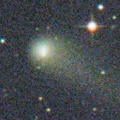
|
It brightened up to 11.1 mag in early 2022 (Mar. 31, 2022, F. Kugel, J.-G. Bosch, J. Nicolas). Now it is 12.5 mag (June 20, Osamu Miyazaki). Fading slowly. In the Northern Hemisphere, it stays observable in good condition. In the Southern Hemisphere, it will be getting lower gradually after this, and it will be unobservable in October.
Date(TT) R.A. (2000) Decl. Delta r Elong. m1 Best Time(A, h)
July 1 15 12.55 21 47.9 4.810 5.288 112 13.8 21:04 ( 27, 75)
July 8 15 12.02 21 39.0 4.921 5.321 107 13.9 21:02 ( 45, 72)
|

|
It approached to Earth down to 0.29 a.u. in early February, and it brightened up to 4.5 mag (Feb. 1, Juan Jose Gonzalez). Now it is 13.1 mag (June 10, Chris Wyatt). Fading slowly. In the Northern Hemisphere, it is not observable now, but it will appear in September. In the Southern Hemisphere, it will be getting higher gradually.
Date(TT) R.A. (2000) Decl. Delta r Elong. m1 Best Time(A, h)
July 1 6 4.96 -20 56.0 3.315 2.691 44 13.9 3:03 (268,-42)
July 8 6 10.33 -22 25.7 3.362 2.770 47 14.1 3:08 (273,-37)
|
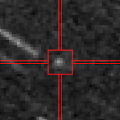
|
It is expected to brighten up to 7.5 mag in October, and it will be observable in excellent condition. Now it is 17.0 mag (June 19, Hiroshi Abe). Brightening rapidly. In the Northern Hemisphere, it stays observable in good condition. In the Southern Hemisphere, it will be getting lower gradually. But it will be getting higher again after September. It is much fainter than this ephemeris recently. However, Thomas Lehmann reported it is bright as 14.7 mag on June 17. In the Southern Hemisphere, it becomes low temporarily around the high light.
Date(TT) R.A. (2000) Decl. Delta r Elong. m1 Best Time(A, h)
July 1 22 57.28 15 55.1 1.123 1.704 105 14.4 3:03 (312, 64)
July 8 23 11.02 18 39.5 1.021 1.642 107 13.9 3:08 (316, 69)
|
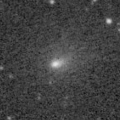
|
Now it is 14.2 mag (June 25, Michael Jager). It will fade out rapidly after this. In the Northern Hemisphere, it stays observable in good condition. In the Southern Hemisphere, it is not observable now, but it will appear in August.
Date(TT) R.A. (2000) Decl. Delta r Elong. m1 Best Time(A, h)
July 1 0 45.29 65 43.2 1.415 1.403 68 14.2 3:03 (207, 49)
July 8 0 11.75 65 53.6 1.285 1.415 74 14.1 3:08 (201, 54)
|

|
The brightness evolution is slower than originally predicted. Now it is 14.1 mag (June 21, Thomas Lehmann). Fading slowly. In the Northern Hemisphere, it is not observable now. It locates somewhat low in the Southern Hemisphere. But it will become high in winter.
Date(TT) R.A. (2000) Decl. Delta r Elong. m1 Best Time(A, h)
July 1 7 18.80 -37 55.3 2.447 2.162 61 14.1 21:04 ( 69,-46)
July 8 7 42.38 -39 39.0 2.461 2.191 62 14.2 21:02 ( 67,-47)
|

|
Now it is 16.9 mag (June 3, Jean-Francois Soulier). It stays 14 mag for a while. Now it is not observable. It will appear in August.
Date(TT) R.A. (2000) Decl. Delta r Elong. m1 Best Time(A, h)
July 1 7 22.06 25 12.0 7.110 6.113 10 14.2 21:04 (131,-10)
July 8 7 27.83 24 56.6 7.126 6.115 5 14.2 21:02 (134,-13)
|
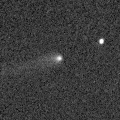
|
Now it is 14.6 mag (June 17, Taras Prystavski). It stays 14 mag for a while. In the Northern Hemisphere, it will be getting higher gradually. In the Southern Hemisphere, it stays observable in good condition.
Date(TT) R.A. (2000) Decl. Delta r Elong. m1 Best Time(A, h)
July 1 2 41.52 5 31.1 3.648 3.250 59 14.4 3:03 (273, 14)
July 8 2 39.50 5 59.8 3.532 3.258 66 14.4 3:08 (278, 22)
|

|
Now it is 14.7 mag (June 13, Jean-Claude Merlin). Fading slowly. It locates somewhat low in the Northern Hemisphere. In the Southern Hemisphere, it stays observable in good condition.
Date(TT) R.A. (2000) Decl. Delta r Elong. m1 Best Time(A, h)
July 1 18 11.87 -25 7.1 1.910 2.923 173 14.5 23:35 ( 0, 30)
July 8 18 6.81 -26 12.4 1.922 2.919 165 14.5 23:02 ( 0, 29)
|
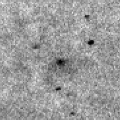
|
Now it is 14.4 mag (June 17, Thomas Lehmann). Fading gradually. In the Northern Hemisphere, it will be getting higher gradually. In the Southern Hemisphere, it stays observable in good condition.
Date(TT) R.A. (2000) Decl. Delta r Elong. m1 Best Time(A, h)
July 1 1 8.32 -3 18.3 1.987 2.139 84 14.6 3:03 (296, 27)
July 8 1 15.70 -2 49.7 1.944 2.177 88 14.7 3:08 (301, 32)
|
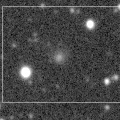
|
Now it is 14.9 mag (June 16, Toshihiko Ikemura, Hirohisa Sato). It stays 15 mag for a while. It will be getting lower gradually after this, and it will be unobservable in October. It is expected to brighten up to 12.5 mag in 2024 spring. At the high light, it will be observable in excellent condition in the Southern Hemisphere, but it will be low in the Northern Hemisphere.
Date(TT) R.A. (2000) Decl. Delta r Elong. m1 Best Time(A, h)
July 1 16 21.03 20 12.0 3.056 3.737 125 14.7 21:43 ( 0, 75)
July 8 16 8.20 18 53.5 3.077 3.691 119 14.7 21:03 ( 0, 74)
|
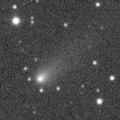
|
Now it is 14.8 mag (June 19, Chris Wyatt). Fading gradually. In the Northern Hemisphere, it will be unobservable in August. In the Southern Hemisphere, it stays observable in good condition.
Date(TT) R.A. (2000) Decl. Delta r Elong. m1 Best Time(A, h)
July 1 13 27.63 -33 15.2 1.843 2.421 112 14.9 21:04 ( 28, 15)
July 8 13 32.43 -33 35.3 1.926 2.433 107 15.1 21:02 ( 32, 13)
|
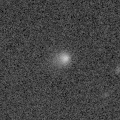
|
Now it is 14.9 mag (June 6, ATLAS Chile). Brightening slowly. In the Northern Hemisphere, it is not observable now, but it will appear in September. In the Southern Hemisphere, it will be unobservable in August. But it will be observable again in September. It is expected to brighten up to 12 mag from 2024 to 2025.
Date(TT) R.A. (2000) Decl. Delta r Elong. m1 Best Time(A, h)
July 1 9 1.63 1 16.4 6.015 5.293 41 15.1 21:04 ( 97, -7)
July 8 9 3.97 1 41.6 6.048 5.252 35 15.1 21:02 (100,-12)
|

|
It will brighten up to 14 mag from 2024 to 2025. Now it is 15.4 mag (June 28, ATLAS Chile). It stays 15 mag for a while. In the Northern Hemisphere, it is not observable now, but it will appear in October. In the Southern Hemisphere, it will be getting lower gradually. But it will be getting higher again after September.
Date(TT) R.A. (2000) Decl. Delta r Elong. m1 Best Time(A, h)
July 1 9 26.94 -27 17.6 6.339 5.980 64 15.3 21:04 ( 69,-18)
July 8 9 32.95 -27 4.3 6.378 5.951 60 15.3 21:02 ( 71,-21)
|

|
Now it is 16.1 mag (June 21, ATLAS South Africa). It stays 15 mag for a while. It stays observable in good condition.
Date(TT) R.A. (2000) Decl. Delta r Elong. m1 Best Time(A, h)
July 1 0 39.27 -5 6.4 3.301 3.481 91 15.3 3:03 (303, 31)
July 8 0 42.87 -4 55.9 3.217 3.495 97 15.3 3:08 (310, 36)
|
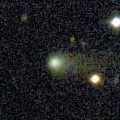
|
Now it is 16.3 mag (June 17, Ken-ichi Kadota). It stays 16 mag for a while. It will be unobservable in August in the Southern Hemisphere, or in September in the Northern Hemisphere. But it will be observable again in October in the Northern Hemisphere.
Date(TT) R.A. (2000) Decl. Delta r Elong. m1 Best Time(A, h)
July 1 10 43.58 23 17.7 4.087 3.619 56 15.8 21:04 (101, 26)
July 8 10 52.36 22 28.2 4.182 3.643 51 15.9 21:02 (103, 22)
|
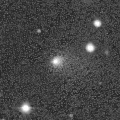
|
It returns for the first time in 70 years. It will brighten up to 4.5 mag in 2024 spring. Now it is 16.3 mag (June 25, Michael Jager). Brightening gradually. In the Northern Hemisphere, it stays observable in good condition. In the Southern Hemisphere, it will be unobservable in August.
Date(TT) R.A. (2000) Decl. Delta r Elong. m1 Best Time(A, h)
July 1 18 50.43 54 34.0 3.745 4.083 102 16.1 0:17 (180, 70)
July 8 18 39.48 55 14.8 3.676 4.012 101 16.0 23:33 (180, 70)
|

|
The ATLAS search program detected its cometary activity in April. It continues to be brightening even after the perihelion passage. Now it is 15.3 mag (July 1, ATLAS South Africa). Fading slowly. It locates somewhat low in the Northern Hemisphere. In the Southern Hemisphere, it stays observable in good condition.
Date(TT) R.A. (2000) Decl. Delta r Elong. m1 Best Time(A, h)
July 1 23 46.76 -24 16.6 2.241 2.762 110 16.0 3:03 (328, 23)
July 8 23 51.99 -24 28.9 2.189 2.779 115 16.0 3:08 (334, 26)
|

|
It brightened up to 13.4 mag in last summer (July 7, 2022, Giuseppe Pappa). Now it is 15.7 mag (June 17, Toshihiko Ikemura, Hirohisa Sato). Fading slowly. In the Northern Hemisphere, it stays observable in good condition. In the Southern Hemisphere, it will be unobservable in October.
Date(TT) R.A. (2000) Decl. Delta r Elong. m1 Best Time(A, h)
July 1 15 53.89 34 7.8 3.591 4.064 110 16.1 21:16 ( 0, 89)
July 8 15 45.41 34 7.8 3.712 4.108 105 16.2 21:02 ( 79, 86)
|

|
It has not been observed yet in this apparition. It will brighten very rapidly, and it is expected to brighten up to 15 mag in summer. It stays 16 mag for a while. It locates somewhat low in the Northern Hemisphere. In the Southern Hemisphere, it stays observable in good condition.
Date(TT) R.A. (2000) Decl. Delta r Elong. m1 Best Time(A, h)
July 1 16 49.32 -35 40.0 1.269 2.225 153 16.4 22:13 ( 0, 19)
July 8 16 45.06 -34 46.2 1.280 2.203 146 16.1 21:41 ( 0, 20)
|

|
It will approach to Sun down to 0.4 a.u. in late September in 2024, and it is expected to brighten up to 0 mag. Now it is 16.1 mag (June 17, Toshihiko Ikemura, Hirohisa Sato). It stays 16 mag for a while. It will be getting lower gradually after this, and it will be unobservable in October. At the high light, in the Northern Hemisphere, it will be observable in good condition after the perihelion passage. In the Southern Hemisphere, it will be observable in the low sky before and after the perihelion passage.
Date(TT) R.A. (2000) Decl. Delta r Elong. m1 Best Time(A, h)
July 1 14 11.57 3 9.6 5.716 6.141 110 16.2 21:04 ( 38, 52)
July 8 14 8.80 2 59.2 5.761 6.074 103 16.1 21:02 ( 47, 48)
|

|
It approached to Earth down to 0.12 a.u. in April, and brightened up to 11.5 mag (Apr. 8, Osamu Miyazaki). Now it is 14.6 mag (June 15, ATLAS Chile). Fading rapidly. It will be fainter than 18 mag soon. In the Northern Hemisphere, it will be getting higher gradually. In the Southern Hemisphere, it stays observable in good condition.
Date(TT) R.A. (2000) Decl. Delta r Elong. m1 Best Time(A, h)
July 1 2 10.72 -2 23.3 0.895 1.097 69 16.3 3:03 (285, 16)
July 8 2 20.06 -1 31.1 0.928 1.167 73 17.0 3:08 (288, 21)
|
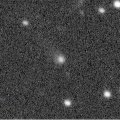
|
Now it is 16.8 mag (June 5, ATLAS Chile). It stays 16 mag for a while. In the Northern Hemisphere, it is not observable now, but it will appear in October. It locates somewhat low in the Southern Hemisphere. But it will become high in autumn.
Date(TT) R.A. (2000) Decl. Delta r Elong. m1 Best Time(A, h)
July 1 8 33.95 -13 56.5 4.412 3.789 46 16.5 21:04 ( 87,-21)
July 8 8 37.73 -14 53.6 4.446 3.776 43 16.5 21:02 ( 90,-26)
|

|
Now it is 15.9 mag (June 19, M. Jaeger, L. Demetz). It will fade out rapidly after this. It will be fainter than 18 mag soon. It stays extremely low in the Northern Hemisphere. In the Southern Hemisphere, it will be unobservable soon. In its last apparition in 2014, it was re-observed after 36-year blank.
Date(TT) R.A. (2000) Decl. Delta r Elong. m1 Best Time(A, h)
July 1 4 46.68 23 48.7 1.619 0.825 25 16.6 3:03 (241, 0)
July 8 5 21.07 25 38.1 1.693 0.871 24 17.3 3:08 (239, 1)
|
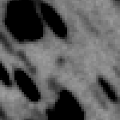
|
Now it is 16.1 mag (June 19, Toshiyuki Takahashi). It stays 17 mag for a while. It stays observable in good condition.
Date(TT) R.A. (2000) Decl. Delta r Elong. m1 Best Time(A, h)
July 1 18 1.69 -11 7.2 1.772 2.767 165 16.7 23:24 ( 0, 44)
July 8 17 56.36 -10 49.7 1.770 2.746 159 16.7 22:52 ( 0, 44)
|

|
Very far object. Now it is 17.0 mag (May 11, ATLAS South Africa). It stays 17 mag for a while. In the Northern Hemisphere, it is not observable now. In the Southern Hemisphere, it stays observable in good condition.
Date(TT) R.A. (2000) Decl. Delta r Elong. m1 Best Time(A, h)
July 1 5 31.48 -67 27.7 10.263 10.339 91 16.8 3:03 (333,-43)
July 8 5 34.98 -67 41.8 10.254 10.337 91 16.8 3:08 (332,-40)
|

|
Now it is 17.4 mag (June 17, Toshihiko Ikemura, Hirohisa Sato). It stays 17 mag for a while. In the Northern Hemisphere, it stays observable in good condition. In the Southern Hemisphere, it will be unobservable in October.
Date(TT) R.A. (2000) Decl. Delta r Elong. m1 Best Time(A, h)
July 1 13 27.47 47 52.5 2.901 2.918 80 16.9 21:04 (127, 62)
July 8 13 35.28 46 12.1 2.935 2.911 78 16.9 21:02 (123, 60)
|
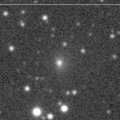
|
It brightened rapidly up to 14.3 mag in April (Apr. 17, Hidetaka Sato). Now it is 16.5 mag (June 18, Hiroshi Abe). It will fade out rapidly after this. It will be fainter than 18 mag soon. It stays observable in good condition.
Date(TT) R.A. (2000) Decl. Delta r Elong. m1 Best Time(A, h)
July 1 13 41.30 2 4.6 1.783 2.253 103 17.0 21:04 ( 46, 47)
July 8 13 50.53 2 38.1 1.916 2.308 99 17.3 21:02 ( 51, 45)
|
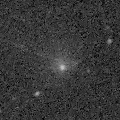
|
Very large comet. It is expected to brighten up to 14 mag in 2031. Now it is 15.9 mag (June 25, Thomas Lehmann). It stays 17 mag for a while. In the Northern Hemisphere, it is not observable now. In the Southern Hemisphere, it stays observable in good condition. In the Northern Hemisphere, it is not observable until 2030.
Date(TT) R.A. (2000) Decl. Delta r Elong. m1 Best Time(A, h)
July 1 3 21.04 -58 44.6 17.447 17.501 91 17.1 3:03 (324,-27)
July 8 3 23.54 -59 5.4 17.383 17.476 93 17.1 3:08 (326,-24)
|

|
Now it is 16.0 mag (June 26, Jean-Claude Merlin). Fading slowly. It will be fainter than 18 mag in September. In the Northern Hemisphere, it will never be observable after this. In the Southern Hemisphere, it stays observable in good condition.
Date(TT) R.A. (2000) Decl. Delta r Elong. m1 Best Time(A, h)
July 1 15 57.12 -76 4.2 1.462 2.193 123 17.2 21:15 ( 0,-21)
July 8 14 46.59 -69 4.9 1.469 2.163 119 17.2 21:02 ( 8,-15)
|
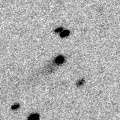
|
Now it is 17.3 mag (June 17, Ken-ichi Kadota). It stays 17 mag for a while. It will be getting lower gradually after this, and it will be unobservable in September. But it will be observable again in October in the Northern Hemisphere.
Date(TT) R.A. (2000) Decl. Delta r Elong. m1 Best Time(A, h)
July 1 12 16.35 14 25.2 9.176 9.048 79 17.2 21:04 ( 79, 40)
July 8 12 15.49 14 20.8 9.302 9.057 73 17.3 21:02 ( 83, 35)
|

|
It brightened up to 13.6 mag in 2021 (June 17, 2021, R. Carstens). Now it is 17.3 mag (June 9, D. Husar, M. Junius, S. Messner). It stays 18 mag for a while. In the Northern Hemisphere, it will never be observable after this. In the Southern Hemisphere, it will be getting lower gradually.
Date(TT) R.A. (2000) Decl. Delta r Elong. m1 Best Time(A, h)
July 1 10 59.54 -63 49.2 6.475 6.737 100 17.4 21:04 ( 27,-23)
July 8 10 59.59 -62 58.9 6.572 6.771 96 17.4 21:02 ( 29,-25)
|

|
Now it is 17.2 mag (June 16, Ken-ichi Kadota). Fading slowly. It will be fainter than 18 mag in August. It stays extremely low in the Northern Hemisphere. It locates somewhat low in the Southern Hemisphere.
Date(TT) R.A. (2000) Decl. Delta r Elong. m1 Best Time(A, h)
July 1 10 35.52 14 18.9 2.637 2.245 56 17.4 21:04 ( 94, 19)
July 8 10 48.10 12 52.9 2.705 2.252 53 17.5 21:02 ( 94, 16)
|

|
It brightened up to 14.1 mag in 2022 spring (Mar. 22, 2022, Chris Wyatt). It was expected to brighten up to 13 mag. But actually, it was fainter than originally expected. Now it is 16.7 mag (June 25, Hidetaka Sato). It stays 18 mag for a while. In the Northern Hemisphere, it will be getting higher gradually. In the Southern Hemisphere, it stays observable in good condition.
Date(TT) R.A. (2000) Decl. Delta r Elong. m1 Best Time(A, h)
July 1 3 4.82 -4 3.9 5.159 4.709 58 17.4 3:03 (278, 4)
July 8 3 5.98 -3 41.9 5.108 4.755 64 17.5 3:08 (282, 11)
|

|
It brightened up to 12.7 mag in last year (Feb. 27, 2022, Jose Guilherme de S. Aguiar). Now it is 17.5 mag (June 16, Toshihiko Ikemura, Hirohisa Sato). Fading gradually. It will be fainter than 18 mag in August. It locates somewhat low in the Northern Hemisphere. In the Southern Hemisphere, it stays observable in good condition.
Date(TT) R.A. (2000) Decl. Delta r Elong. m1 Best Time(A, h)
July 1 19 49.86 -26 24.8 2.126 3.114 163 17.5 1:17 ( 0, 29)
July 8 19 43.87 -26 41.3 2.132 3.139 170 17.6 0:44 ( 0, 28)
|

|
First return of a new periodic comet which brightened up to 15 mag in 2008. Now it is 18.2 mag (June 16, Toshihiko Ikemura, Hirohisa Sato). It stays 18 mag for a while. In the Northern Hemisphere, it will be getting higher gradually. It locates somewhat low in the Southern Hemisphere. But it will become high in autumn.
Date(TT) R.A. (2000) Decl. Delta r Elong. m1 Best Time(A, h)
July 1 2 23.21 22 18.3 2.749 2.375 58 17.5 3:03 (261, 27)
July 8 2 35.85 22 35.1 2.692 2.387 61 17.5 3:08 (263, 31)
|

|
It is expected to brighten up to 14 mag in winter. Now it is 19.8 mag (June 30, Masayuki Suzuki). Brightening gradually. In the Northern Hemisphere, it will be getting higher gradually. In the Southern Hemisphere, it stays observable in good condition.
Date(TT) R.A. (2000) Decl. Delta r Elong. m1 Best Time(A, h)
July 1 2 22.28 8 40.4 3.490 3.153 62 17.7 3:03 (273, 20)
July 8 2 30.29 9 23.1 3.367 3.116 67 17.6 3:08 (276, 26)
|

|
Now it is 17.8 mag (Feb. 26, Jean-Claude Merlin). It stays 17 mag for a while. In the Northern Hemisphere, it is not observable now, but it will be observable soon. In the Southern Hemisphere, it will be getting higher gradually.
Date(TT) R.A. (2000) Decl. Delta r Elong. m1 Best Time(A, h)
July 1 4 27.05 -8 56.5 8.582 7.899 45 17.6 3:03 (270,-15)
July 8 4 30.97 -8 53.6 8.490 7.866 49 17.6 3:08 (274,-10)
|

|
It showed cometary activity in 2023, and brightened rapidly. Now it is 17.4 mag (June 22, ATLAS South Africa). Fading slowly. It will be fainter than 18 mag in August. It stays extremely low in the Northern Hemisphere. In the Southern Hemisphere, it stays observable in good condition.
Date(TT) R.A. (2000) Decl. Delta r Elong. m1 Best Time(A, h)
July 1 14 16.13 -40 49.7 2.763 3.427 123 17.6 21:04 ( 16, 12)
July 8 14 18.43 -40 2.2 2.840 3.433 117 17.7 21:02 ( 20, 11)
|

|
It is expected to brighten up to 14 mag in 2024 summer. At the high light, it is not observable in the Northern Hemisphere. Now it is 18.6 mag (Feb. 16, Toshihiko Ikemura, Hirohisa Sato). Brightening gradually. In the Northern Hemisphere, it will be getting higher gradually. In the Southern Hemisphere, it stays observable in good condition.
Date(TT) R.A. (2000) Decl. Delta r Elong. m1 Best Time(A, h)
July 1 3 11.99 9 26.7 5.226 4.652 50 17.8 3:03 (266, 10)
July 8 3 15.89 8 51.9 5.079 4.602 56 17.7 3:08 (270, 16)
|

|
Rob Matson discovered it as a bright new comet as 11 mag from SWAN images between Apr. 5 and 15. It was revealed to be an asteroid which has been observed also in 2012 and 2018. It approached to Sun down to 0.5 a.u. on Mar. 29. Now it is 17.6 mag (June 15, Jean-Claude Merlin). Fading rapidly. It will be fainter than 18 mag soon. It locates somewhat low in the Northern Hemisphere. In the Southern Hemisphere, it stays observable in good condition.
Date(TT) R.A. (2000) Decl. Delta r Elong. m1 Best Time(A, h)
July 1 15 38.75 -43 19.1 0.776 1.677 138 17.7 21:04 ( 0, 12)
July 8 15 43.76 -39 3.3 0.896 1.762 134 18.2 21:02 ( 4, 16)
|
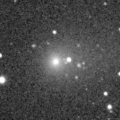
|
It brightened up to 12.4 mag in winter (Feb. 10, Taras Prystavski). Now it is 17.8 mag (June 17, Ken-ichi Kadota). Fading gradually. It will be fainter than 18 mag soon. It locates somewhat low.
Date(TT) R.A. (2000) Decl. Delta r Elong. m1 Best Time(A, h)
July 1 10 50.38 13 15.9 2.861 2.520 60 17.7 21:04 ( 91, 22)
July 8 11 1.30 12 14.8 2.967 2.553 56 17.9 21:02 ( 92, 18)
|

|
It will brighten up to 16 mag in next winter. Now it is 17.9 mag (June 16, Toshihiko Ikemura, Hirohisa Sato). It stays 17 mag for a while. In the Northern Hemisphere, it will be getting lower gradually after this, and it will be unobservable in September. But it will be observable again in September. In the Southern Hemisphere, it is not observable now.
Date(TT) R.A. (2000) Decl. Delta r Elong. m1 Best Time(A, h)
July 1 11 13.28 60 32.3 2.856 2.502 59 17.8 21:04 (143, 41)
July 8 11 11.27 56 51.8 2.885 2.459 55 17.7 21:02 (138, 37)
|
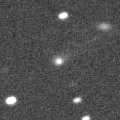
|
It brightened up to 15.9 mag in 2022 spring (May 5, Toshiyuki Takahashi). Now it is 17.1 mag (June 17, Toshiyuki Takahashi). It stays 18 mag for a while. It locates somewhat low in the Northern Hemisphere. In the Southern Hemisphere, it stays observable in good condition.
Date(TT) R.A. (2000) Decl. Delta r Elong. m1 Best Time(A, h)
July 1 15 54.99 -23 49.0 4.138 4.987 142 17.7 21:19 ( 0, 31)
July 8 15 53.16 -23 43.0 4.216 4.995 135 17.8 21:02 ( 3, 31)
|

|
Now it is 17.4 mag (June 29, ATLAS-HKO, Haleakala). It stays 18 mag for a while. In the Northern Hemisphere, it stays observable in good condition. In the Southern Hemisphere, it will never be observable after this.
Date(TT) R.A. (2000) Decl. Delta r Elong. m1 Best Time(A, h)
July 1 15 30.08 79 47.6 10.294 10.061 74 17.8 21:04 (179, 45)
July 8 15 15.27 79 23.0 10.324 10.080 73 17.8 21:02 (176, 45)
|
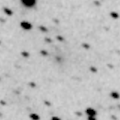
|
It brightened up to 14.9 mag in winter (Feb. 28, Hidetaka Sato). Now it is 19.2 mag (June 17, Toshihiko Ikemura, Hirohisa Sato). Fading gradually. It will be fainter than 18 mag soon. In the Northern Hemisphere, it stays observable in good condition. It locates somewhat low in the Southern Hemisphere.
Date(TT) R.A. (2000) Decl. Delta r Elong. m1 Best Time(A, h)
July 1 22 23.94 27 23.2 2.069 2.538 105 17.9 3:03 (303, 77)
July 8 22 21.80 28 55.1 2.049 2.583 110 18.0 3:08 (334, 83)
|
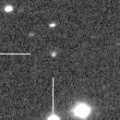
|
It will brighten up to 16 mag in 2024 spring. Now it is 18.3 mag (May 24, ATLAS South Africa). It stays 18 mag for a while. In the Northern Hemisphere, it is not observable now, but it will appear in October. In the Southern Hemisphere, it will be getting lower gradually after this, and it will be unobservable in August. But it will be observable again in October.
Date(TT) R.A. (2000) Decl. Delta r Elong. m1 Best Time(A, h)
July 1 9 24.85 -5 10.3 4.625 4.042 49 17.9 21:04 ( 88, -6)
July 8 9 32.63 -5 28.1 4.657 4.010 45 17.9 21:02 ( 90,-10)
|

|
It stays 18 mag for a while. In the Northern Hemisphere, it will be getting higher gradually. In the Southern Hemisphere, it stays observable in good condition.
Date(TT) R.A. (2000) Decl. Delta r Elong. m1 Best Time(A, h)
July 1 2 44.63 7 45.8 3.365 2.951 57 18.0 3:03 (271, 15)
July 8 2 53.90 8 9.7 3.292 2.957 62 17.9 3:08 (274, 20)
|

|
It was predicted to brighten up to 16 mag in 2023. But actually, it is very faint as 18.8 mag (June 26, Jean-Claude Merlin). Fading slowly. In the Northern Hemisphere, it is not observable now. In the Southern Hemisphere, it stays observable in good condition.
Date(TT) R.A. (2000) Decl. Delta r Elong. m1 Best Time(A, h)
July 1 19 38.89 -77 1.5 2.812 3.503 125 18.3 1:09 ( 0,-22)
July 8 19 18.64 -76 7.4 2.829 3.528 126 18.3 0:21 ( 0,-21)
|
|
![]()
 C/2023 A3 ( Tsuchinshan-ATLAS )
C/2023 A3 ( Tsuchinshan-ATLAS ) 364P/PanSTARRS
364P/PanSTARRS C/2022 A3 ( Lemmon-ATLAS )
C/2022 A3 ( Lemmon-ATLAS ) 72P/Denning-Fujikawa
72P/Denning-Fujikawa 219P/LINEAR
219P/LINEAR C/2019 E3 ( ATLAS )
C/2019 E3 ( ATLAS ) C/2022 U4 ( Bok )
C/2022 U4 ( Bok ) C/2023 B2 ( ATLAS )
C/2023 B2 ( ATLAS ) C/2014 UN271 ( Bernardinelli-Bernstein )
C/2014 UN271 ( Bernardinelli-Bernstein ) C/2023 K1 ( ATLAS )
C/2023 K1 ( ATLAS ) C/2020 F2 ( ATLAS )
C/2020 F2 ( ATLAS ) C/2018 U1 ( Lemmon )
C/2018 U1 ( Lemmon ) 94P/Russell 4
94P/Russell 4 C/2020 Y2 ( ATLAS )
C/2020 Y2 ( ATLAS ) 116P/Wild 4
116P/Wild 4 P/2023 L1 ( Hill )
P/2023 L1 ( Hill ) 32P/Comas Sola
32P/Comas Sola C/2022 QE78 ( ATLAS )
C/2022 QE78 ( ATLAS ) P/2014 OL465 ( PanSTARRS )
P/2014 OL465 ( PanSTARRS ) C/2022 S4 ( Lemmon )
C/2022 S4 ( Lemmon ) P/2018 HT3 ( NEOWISE )
P/2018 HT3 ( NEOWISE ) 118P/Shoemaker-Levy 4
118P/Shoemaker-Levy 4 C/2022 V2 ( Lemmon )
C/2022 V2 ( Lemmon ) 99P/Kowal 1
99P/Kowal 1 C/2019 O3 ( Palomar )
C/2019 O3 ( Palomar ) 80P/Peters-Hartley
80P/Peters-Hartley C/2022 T1 ( Lemmon )
C/2022 T1 ( Lemmon ) 170P/Christensen
170P/Christensen C/2021 C5 ( PanSTARRS )
C/2021 C5 ( PanSTARRS )![]()






















































